Downtown Crossing station
Downtown Crossing station (often known as DTX[2]), is a rapid transit station located in the Downtown Crossing retail district in downtown Boston, Massachusetts. It is the junction of the Massachusetts Bay Transportation Authority (MBTA) Orange Line and Red Line, and is one of four "hub stations" on the MBTA subway system. Downtown Crossing is also a major bus transfer location serving 13 MBTA bus routes, including one Silver Line route.
Downtown Crossing | ||||||||||||||||||||||
|---|---|---|---|---|---|---|---|---|---|---|---|---|---|---|---|---|---|---|---|---|---|---|
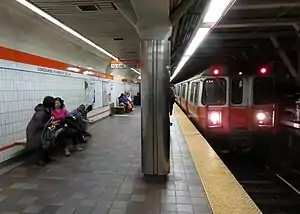 A northbound Orange Line train at Downtown Crossing in 2018 | ||||||||||||||||||||||
| Location | Summer Street at Washington Street Boston, Massachusetts | |||||||||||||||||||||
| Coordinates | 42°21′19″N 71°03′38″W | |||||||||||||||||||||
| Owned by | Massachusetts Bay Transportation Authority | |||||||||||||||||||||
| Line(s) | Washington Street Tunnel Cambridge-Dorchester Tunnel | |||||||||||||||||||||
| Platforms | 2 side platforms (Orange Line) 2 side platforms (Red Line) | |||||||||||||||||||||
| Tracks | 2 (Orange Line) 2 (Red Line) | |||||||||||||||||||||
| Connections | Via Winter Street Concourse to Park Street: | |||||||||||||||||||||
| Construction | ||||||||||||||||||||||
| Platform levels | 2 | |||||||||||||||||||||
| Disabled access | Yes | |||||||||||||||||||||
| History | ||||||||||||||||||||||
| Opened | November 30, 1908 (Orange Line) April 4, 1915 (Red Line) July 24, 2002 (Silver Line) | |||||||||||||||||||||
| Previous names | Washington (Red Line, 1915–1987; Orange Line, 1967–1987) Winter–Summer (Orange Line, 1908–1967) | |||||||||||||||||||||
| Passengers | ||||||||||||||||||||||
| FY2019 | 24,074 (weekday average boardings)[1] | |||||||||||||||||||||
| Services | ||||||||||||||||||||||
| ||||||||||||||||||||||
Downtown Crossing station is two levels deep. The upper (Orange Line) level, which opened in 1908, stretches from Temple Place to Franklin Street under Washington Street. The lower (Red Line) level, which opened in 1915, reaches from Washington Street to Chauncey Street under Summer Street. Downtown Crossing is the second busiest subway station in the MBTA network (behind only South Station), with an average of 24,074 entries per weekday in FY2019.[1] The Winter Street Concourse (opened in March 1979) allows access to the Green Line at Park Street without leaving the common paid area.
Station layout
Downtown Crossing has two platform levels, both underground. The upper level serves the Orange Line and houses the CharlieCard Store, the entrance to the Winter Street Concourse, and entrances to various retailers, such as Roche Bros. and Macy's. The lower level platforms serve Red Line trains.
| G | Street level | Exit/entrance, buses, SL5 stop |
| B1 | Side platform | |
| Southbound | ← Orange Line toward Forest Hills (Chinatown) | |
| Northbound | Orange Line toward Oak Grove (State) → | |
| Side platform | ||
| Mezzanine | Fare control, Winter Street Concourse to Park Street station | |
| B2 | Side platform | |
| Northbound | ← Red Line toward Alewife (Park Street) | |
| Southbound | Red Line toward Ashmont or Braintree (South Station) → | |
| Side platform | ||
Accessibility

Like all Orange Line and Red Line stations, Downtown Crossing is accessible. Surface elevators are located at the Winter Street, Franklin Street, and Hawley Street entrances.[3] An additional elevator – open business hours only – leads to the Roche Brothers store which connects to the Summer Street concourse. Because Downtown Crossing is an older station built at two different times in a dense urban area, transfers between the two lines are convoluted. There is no elevator between either of the Red Line platforms and the southbound Orange Line platform; passengers making such transfers must use the Winter Street Concourse and the Red Line elevators at Park Street.
The northbound Red Line platform has elevators at both ends of the Summer Street concourse for connections to the northbound Orange Line and to the street. The southbound Red Line platform only has an elevator at its far east end; passengers transferring to and from the northbound Orange Line must leave fare control at one end of the concourse and reenter at the other end.
A $13.57 million project added the two elevators connecting the northbound Orange Line platform to the northbound Red Line platform. Notice to proceed was given on February 18, 2016; completion was originally expected in late 2017, but delayed until June 14, 2019.[4][5]
Two additional phases will complete elevator connections for all transfers.[6] The $50 million Phase II will add an elevator between the northbound Orange Line and southbound Red Line platforms, renovate the elevator from Winter Street to the southbound Orange Line platform to also serve the southbound Red Line, and enlarge the Red Line elevator at Park Street. A $6.9 million design contract was awarded in March 2020; construction is expected to last from April 2022 to April 2024.[7] The Phase II improvements are part of the 2006 settlement of Joanne Daniels-Finegold, et al. v. MBTA.[8] Original plans in that settlement for an elevator between the northbound Red Line and southbound Orange Line were found to be infeasible; as part of a 2018 amendment to the settlement, the enlargement of the Park Street elevator was substituted.[9]
History
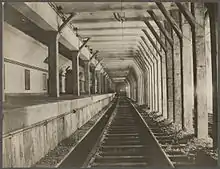
The Washington Street tunnel carrying the Main Line Elevated (later the Orange Line) opened on November 30, 1908.[10] Stations on the tunnel were built in pairs with different names and separate entrances, an appeasement to merchants on the street who desired maximal pedestrian traffic. Stations were located at Summer northbound with entrances at Summer Street and Franklin Street, and Winter southbound with entrances at Winter Street and Temple Place.
The Dorchester extension of the Cambridge tunnel (now the Red Line) was built one level below the Washington Street tunnel. Washington station opened on April 4, 1915, with additional entrances on Summer Street at Hawley Street and Chauncey Street.[10]
As part of a system-wide rebranding by the newly formed MBTA, on January 23, 1967, the Orange Line platforms were renamed Washington as well.[10] On May 3, 1987, the name was changed again to Downtown Crossing after the surrounding retail district, with Washington as a secondary name.[10] The renaming, which had been approved in 1985 as part of a series of station name changes, was coordinated with the opening of the Southwest Corridor.[11]
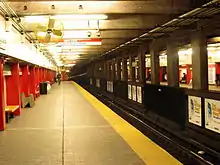
The 1970s saw the first major renovations to the station in decades. In 1972, the agency received a federal grant that funded two-thirds of a $14.3 million modernization program for downtown stations, including $2 million for Washington station.[12] As part of that project, the MBTA investigated the feasibility of connecting Essex, Park Street, Washington, and State with pedestrian tunnels.[13]
The Franklin Street entrance was originally inside a building on the north side of the street.[14] The construction of the 350 Washington Street building beginning in 1965 demolished the older building and widened the street.[15][16] A rebuilt entrance slightly to the north was incorporated into the new building.[17] It was later replaced by a freestanding headhouse, approximately at the original location, in Shopper's Park. The MBTA proposed to make the headhouse exit-only during budget cuts in 1981.[18] On August 10, 2015, the entrance was temporarily closed for construction of the Millennium Tower, which constructed a new sloping seating area over the entrance.[19][20][15] The renovated headhouse reopened on September 12, 2016.[21]
Originally, the Orange Line level had an underground concourse with several direct access points to basement entrances of various stores in the district, such as Jordan Marsh (now Macy's) and the former Filene's department store. In 1979, the Winter Street Concourse was opened, connecting the upper level of Downtown Crossing station (inside fare control) to the upper level of Park Street station two blocks away, utilizing an existing but previously unopened section of the concourse.[22] Both levels of the station were substantially renovated and accessibility was improved in the mid-1980s. The 101 Arch Street building, completed in 1989, included access to the Summer Street concourse (including an elevator) through its basement level.[23][24] By 1991, a 1914-installed wooden escalator in the station was the oldest operating escalator in the world.[25]
Modernization in the 1980s included the installation of Situations, a set of 31 skewed marble seats designed by Buster Simpson along the Red Line platform.[26] In August 1987, the MBTA board approved plans for an MBTA Transit Police substation in the Summer Street Concourse.[27] The $950,000 substation opened on July 26, 1988.[28]
Silver Line service from Downtown Crossing to Dudley Square began on July 24, 2002.[10] The Temple Place entrance to the southbound Orange Line platform was reopened to allow easier transfers.[29] On June 24, 2019, the MBTA Board awarded a $29.7 million, 16-month contract for full cleaning, wayfinding signage replacement, and other improvements at North Station, Haymarket, State, and Downtown Crossing stations.[30] As of May 2020, that work is expected to be complete by the end of 2020.[31]
CharlieCard Store
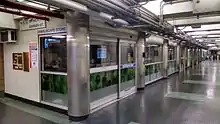
A ticket counter was formerly located on the mezzanine level of the station (outside fare control) under Winter Street east of Washington Street. On August 13, 2012, the MBTA combined customer services (formerly located in a booth at Back Bay station) into the Downtown Crossing location as the "CharlieCard Store".[32] The store provides services including obtaining special passes for blind, senior, disabled, and other users; transferring value between fare media; and the purchase of regular passes (the last of which can also be done at any unmanned fare machine).[33] Due to unreliable computer systems and high demand, the store experiences long wait times.[34]
Bus connections
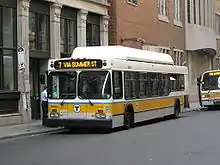
A number of MBTA bus routes have Downtown Crossing station as their downtown terminus. These include local routes to Charlestown, South Boston, and the North Shore, express buses which run via the Massachusetts Turnpike, and the bus rapid transit Silver Line to Dorchester.[3]
Most routes stop on Otis Street at Summer Street, a short block east of the nearest subway entrance:[3]
- 7: City Point - Otis Street & Summer Street
- 501: Brighton Center - Federal Street & Franklin Street
- 504: Watertown Yard - Federal Street & Franklin Street
- 505: Waltham Center - Federal Street & Franklin Street
- 553: Roberts - Federal Street & Franklin Street
- 554: Waverley Square - Federal Street & Franklin Street
- 556: Waltham Highlands - Federal Street & Franklin Street
- 558: Riverside - Federal Street & Franklin Street
One route stops on Bedford Street at Kingston Street, an additional block to the south:[3]
- 11: City Point - Bedford Street & Chauncy Street
One Silver Line route serves Downtown Crossing at a midblock bus stop on Temple Place, half a block from the nearest subway entrance:[3]
- SL5: Nubian station–Downtown Crossing at Temple Place
The 92 and 93 routes stopped at Downtown Crossing until they were cut back to Milk Street in August 2014.[10][3]
References
- "A Guide to Ridership Data". MassDOT/MBTA Office of Performance Management and Innovation. June 22, 2020. p. 6.
- "MBTA Capital Acceleration Coordination: Capital Programs Committee". Massachusetts Bay Transportation Authority. September 11, 2019. p. 10.
- "Downtown Crossing Station Neighborhood Map" (PDF). Massachusetts Bay Transportation Authority. April 2012. Retrieved 27 September 2015.
- "Downtown Crossing (DTX) Vertical Transportation and Station Improvements". Business Center. Massachusetts Bay Transportation Authority. Retrieved January 24, 2017.
- Brelsford, Laura (November 26, 2019). "SWA Initiatives – November 2019" (PDF). p. 8.
- Brelsford, Laura (December 5, 2016). "MBTA System-Wide Accessibility Initiatives: December 2016 Update" (PDF). Massachusetts Bay Transportation Authority Department of System-Wide Accessibility. pp. 11, 29.
- McCormack, John (March 23, 2020). "MBTA Contract No. A90PS01: Engineering and Design Services for the MBTA Downtown Crossing Station Accessibility Improvements Project, Phase II" (PDF). Massachusetts Bay Transportation Authority.
- "Settlement Agreement" (PDF). Joanne Daniels-Finegold et al. v. MBTA. April 10, 2006. p. 18.
- "AMENDED SETTLEMENT AGREEMENT (With Attachments A, B and C and Exhibit X)" (PDF). Joanne Daniels-Finegold et al. v. MBTA. December 4, 2018. pp. 15, 16.
- Belcher, Jonathan. "Changes to Transit Service in the MBTA district" (PDF). NETransit.
- Crocket, Douglas S. (July 27, 1985). "T board votes to change the names of some stations". Boston Globe. p. 26 – via Newspapers.com.

- Carr, Robert B. (July 26, 1972). "Park St. station facelift due". Boston Globe. p. 3 – via Newspapers.com.

- Plotkin, A.S. (March 1, 1974). "4 downtown MBTA stops may be linked". Boston Globe. p. 5 – via Newspapers.com.

- "Plate 1: Part of Wards 5&8". Atlas of the City of Boston, Boston Proper and Back Bay. G.W. Bromley & Co. 1917 – via Ward Maps.
- "Transformation of Boston's Midtown Cultural District". Handel Architects. October 16, 2014.
- "2016 BOMA Boston TOBY & Industry Awards" (PDF). BOMA Boston. 2016. p. 8.
- Sixth Annual Report. Massachusetts Bay Transportation Authority. 1970. pp. 12, 18 – via Internet Archive.
- Massachusetts Bay Transportation Authority (February 13, 1981). "Public Hearing Notice". Boston Globe. p. 50 – via Newspapers.com.

- "Subway Service Alerts: Orange Line". Massachusetts Bay Transportation Authority. August 18, 2015. Archived from the original on February 7, 2016.
- Turner, Greg (August 17, 2012). "Downtown park will be step up". Boston Herald.
- "AACT MEETING – September 28, 2016" (PDF). MBTA Department of System-wide Accessibility. September 28, 2016.
- Clarke, Bradley H.; Cummings, O.R. (1997). Tremont Street Subway: A Century of Public Service. Boston Street Railway Association. p. 49. ISBN 0938315048.
- "Amended and Restated Development Plan for Planned Development Area No. 18". Boston Redevelopment Authority. May 1, 1985. p. 13.
- "101 Arch: Only Building that Provides Indoor Access to MBTA" (PDF). Boston Global Investors.
- "World's Oldest Running Escalator Gives Bostonians a Boost". Tulsa World. March 14, 1991.
- Howe, Peter J. (April 27, 1988). "MBTA hopes riders will be transported by art". Boston Globe. pp. 21, 35 – via Newspapers.com. (second page)

- Howe, Peter J. (August 23, 1987). "MBTA to build police facility, South Attleboro rail station". Boston Globe. p. 34 – via Newspapers.com.

- "MBTA crime is dropping as the police force grows". Boston Globe. August 27, 1988. p. 28 – via Newspapers.com.

- "Ridership and Service Statistics" (PDF) (14th ed.). Massachusetts Bay Transportation Authority. 2014.
- "MBTA Contract No. A01CN01: Wayfinding and Station Improvements - Four Stations (Downtown Crossing, State, Haymarket, and North Station)" (PDF). Massachusetts Bay Transportation Authority. June 24, 2019.
- Brelsford, Laura (May 26, 2020). "SWA Initiatives – May 2020" (PDF). p. 5.
- Rocheleau, Matt (13 August 2012). "MBTA opens new CharlieCard Store inside Downtown Crossing Station". Boston Globe. Retrieved 24 September 2015.
- "CharlieCard Store". Massachusetts Bay Transportation Authority. Retrieved 28 June 2014.
- Helms, Chris (15 August 2012). "Hour Waits Common as MBTA's New CharlieCard Store Opens in Downtown Crossing". Charlestown Patch. Retrieved 24 September 2015.
External links
| Wikimedia Commons has media related to Downtown Crossing station. |
- MBTA - Downtown Crossing
- Entrances on Google Maps Street View: Washington at Winter, Summer at Washington, Temple Place, 101 Arch Street, Chauncy Street, Franklin Street